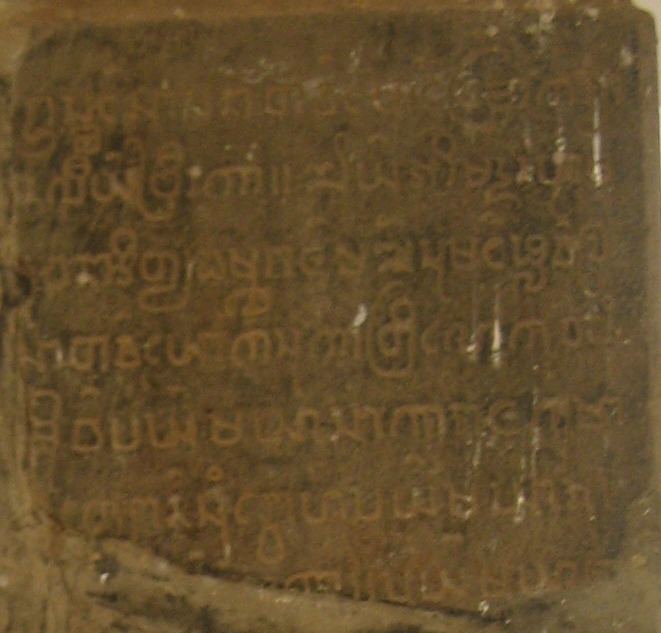Region Pagan Linguist list obr | Era 12th–16th centuries ISO 639-3 obr | |
 | ||
Language family Sino-Tibetan(Tibeto-Burman)Lolo–BurmeseBurmishOld Burmese | ||
Old Burmese was an early form of the Burmese language, as attested in the stone inscriptions of Pagan, and is the oldest phase of Burmese linguistic history. The transition to Middle Burmese occurred in the 16th century. The transition to Middle Burmese included phonological changes (e.g. mergers of sound pairs that were distinct in Old Burmese) as well as accompanying changes in the underlying orthography. Word order, grammatical structure and vocabulary have remained markedly comparable, well into Modern Burmese, with the exception of lexical content (e.g. function words).
Contents
Phonology
Unlike most Tibeto-Burman languages, Burmese has a phonological system with two-way aspiration: preaspiration (e.g. မှ hma. vs. မ ma.) and postaspiration (e.g. ခ kha. vs. က ka.). In Burmese, this distinction serves to differentiate causative and non-causative verbs of Sino-Tibetan etymology.
In Old Burmese, postaspiration can be reconstructed to the proto-Burmese language, whereas preaspiration is comparatively newer, having derived from proto-prefixes. The merging of proto-prefixes (i.e., ဟ as an independent consonant used as a prefix) to preaspirated consonants was nearly complete by the 12th century.
Orthography
Old Burmese maintains a number of distinctions which are no longer present in the orthography of standard Burmese.
Diacritics
Whereas Modern Standard Burmese uses 3 written medials (/-y-/, /-w-/, and /-r-/), Old Burmese had a fourth written medial /-l-/, which was typically written as a stacked consonant ္လ underneath the letter being modified.
Old Burmese orthography treated the preaspirated consonant as a separate segment, since a special diacritic (ha hto, ှ) had not yet been innovated. As such, the letter ha (ဟ) was stacked above the consonant being modified (e.g. ဟ္မ where Modern Burmese uses မှ).
Gloss
Examples of such differences include the consonant yh- and the lateral clusters kl- and khl-. The earliest Old Burmese documents, in particular the Myazedi and Lokatheikpan inscriptions frequently have -o- where later Burmese has -wa. Old Burmese also had a final -at and -an distinct from -ac and -any as shown by Nishi (1974).
Vocabulary
Aside from Pali, the Mon language had significant influence on Old Burmese orthography and vocabulary, as Old Burmese borrowed many lexical items (especially relating to handicrafts, administration, flora and fauna, navigation and architecture), although grammatical influence was minimal. Many Mon loan words are present in Old Burmese inscriptions, including words that were absent in the Burmese vocabulary and those that substituted original Burmese words. Examples include:
Moreover, Mon influenced Old Burmese orthography, particularly with regard to preference for certain spelling conventions:
Grammar
Two grammatical markers presently found in Modern Burmese are extant to Old Burmese:
In Old Burmese, ၍ was spelt ruy-e, following the pattern in Pali, whose inflected verbs can express the main predicate.
Pali also had an influence in the construction of written Old Burmese verbal modifiers. Whereas in Modern Burmese, the verb + သော (sau:) construction can only modify the succeeding noun (e.g. ချစ်သောလူ, "man who loves") and သူ (su) can only modify the preceding verb (e.g. ချစ်သူ, "lover"), in Old Burmese, both constructions, verb + သော and verb + သူ were interchangeable. This was a consequence of Pali grammar, which dictates that participles can be used in noun functions.
Pali grammar also influenced negation in written Old Burmese, as many Old Burmese inscriptions adopt the Pali method of negation. In Burmese, negation is accomplished by prefixing a negative particle မ (ma.) to the verb being negated. In Pali, အ (a.) is used instead.
Such grammatical influences from Pali on written Old Burmese had disappeared by the 15th century.
Surviving inscriptions
The earliest evidence of Burmese script (inscription at the Mahabodhi Temple in India) is dated to 1035, while an 18th-century recast stone inscription points to 984. Perhaps the most well known inscription is the Old Burmese face of the Myazedi inscription. The most complete set of Old Burmese inscriptions, called She-haung Myanma Kyauksa Mya (ရှေးဟောင်း မြန်မာ ကျောက်စာများ; lit. "Ancient Stone Inscriptions of Myanmar") was published by Yangon University's Department of Archaeology in five volumes from 1972 to 1987.
